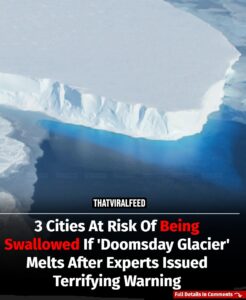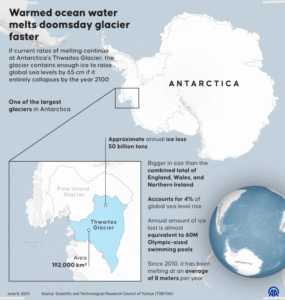Melting ‘Doomsday Glacier’ Could Threaten These 3 Major Cities, Experts Say

Three major global cities could be at grave risk if a massive Antarctic glacier continues to deteriorate, scientists warn.
Climate change has already made its presence felt across the globe—rising temperatures, extreme weather, and increasing sea levels have become impossible to ignore. Now, new research shines a light on the potentially catastrophic impact of one of Antarctica’s most unstable ice masses: the Thwaites Glacier, ominously nicknamed the “Doomsday Glacier.”
This massive glacier holds enough frozen water to raise global sea levels by more than two feet if it melts completely. But the danger doesn’t stop there.
Thwaites acts as a natural barrier, essentially a “cork,” holding back the much larger West Antarctic Ice Sheet. If this glacier were to collapse entirely, the result could be a global sea level rise of up to 10 feet. The consequences would be devastating—especially for cities like London, New York, and Bangkok, which could find themselves submerged or severely damaged.
These urban centers, each rich in history and culture, draw millions of visitors every year. But under this worst-case scenario, they could become uninhabitable within generations.
Research teams have been closely monitoring Thwaites in an effort to understand how quickly it’s deteriorating and how much risk it truly poses. One of the more troubling discoveries has been the presence of “hidden lakes” buried deep within the glacier. These internal water reservoirs appear to accelerate the melting process more than previously understood.

The International Thwaites Glacier Collaboration (ITGC), which has been studying the glacier since 2018, has found alarming signs that the ice is retreating faster than projected. If this rapid loss continues, scientists estimate that Thwaites could disintegrate entirely within the next two centuries.
Professor Noel Gourmelen, who helped lead a March 2025 study through ITGC, explained the significance of this hidden water: “We long suspected that water flowing underneath the ice played a role in speeding up melting—but the scale of this particular drainage event gave us the data we needed to prove it.”
According to Gourmelen, the outflow occurred in a particularly vulnerable area, effectively accelerating the glacier’s retreat by allowing ocean water to eat away at it even faster.
Compounding the problem, 2025 has brought record-breaking warmth to the Southern Hemisphere. Scientists believe these higher-than-normal temperatures have made an already fragile situation worse.
Dr. Alastair Graham of the University of South Florida told News.com.au: “A full collapse of Thwaites could raise sea levels by about 65 centimeters (25 inches).” He added that the current year has been especially concerning. “This is not something we can easily bounce back from. The dynamics have shifted.”
As climate conditions continue to change, scientists say the time for bold action is running out. Without significant intervention, the Doomsday Glacier might live up to its chilling nickname—dragging parts of the modern world down with it.